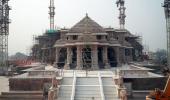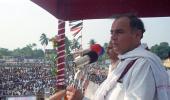As the temple is inaugurated, unfortunately for Advani but unsurprisingly for the rest of us, the architect of the party's rise will not lead the ceremony and claim credit for his achievement, notes Aakar Patel.

The temple inauguration in Ayodhya closes a chapter in our history that many youngsters will not know about, but the rest of us have lived through.
It concerns the BJP, the reasons for its rise after four decades of stagnation and the man who elevated and energised it.
p>In the last general election before it merged into the umbrella opposition Janata Party, the Jana Sangh under Vajpayee, contesting in an alliance with a couple of other parties, won 22 seats.
In the four preceding general elections it had won only 3, 4, 14 and 35 seats and never had a national vote share of more than 9 per cent.
In its official history, the party describes the last state assembly elections it contested on its own: 'In the 1972 Assembly Elections (for various states across India), Jana Sangh went to poll largely on its own. It fielded 1233 candidates and won 104 seats with an overall 8 per cent of the votes. In almost all the states it suffered losses... For the first time since its founding, Jana Sangh could not improve upon its earlier performance.'
The party had plateaued and this became clear when it again contested the 1984 general elections on its own, winning 7 per cent of the vote and only two Lok Sabha seats.
When Advani took charge of the party in 1986, he had never been a participant in electoral politics.
His entry into politics came after time spent as a journalist in the RSS magazine, where he wrote film reviews.
As a politician, Advani had always been a nominated member, whether in the Delhi Council or in the Rajya Sabha.
He had no experience of political mass mobilisation and, going by his autobiography (My Country, My Life, published in 2008) does not appear to know how it worked.
The Ayodhya issue had actually been launched by the non-political groups inside the RSS, led by the Vishwa Hindu Parishad.
At a meeting in UP in 1983, Rajendra Singh, who would later become RSS chief, demanded that the Babri Masjid be opened to Hindu devotees.
In September 1984, the VHP began a campaign against the mosque.
This received sufficient public response for the group to claim in 1986 that they would forcibly break the locks open.
Prime Minister Rajiv Gandhi succumbed to the pressure and his government told the courts there would be no law and order problem if this happened.
The locks were thus opened and Hindus allowed into the mosque.
But the VHP did not stop with being given access to worship at the site: Its goal was the razing of the mosque.
In February 1989, at the Kumbh Mela in Allahabad, the VHP said it would lay the foundation stone for the temple in November.
This would involve the making of bricks across the country and their being carried in processions through towns and villages to Ayodhya in November.
Till this time, Advani writes in his autobiography, a few members of the BJP like Vijayaraje Scindia and Vinay Katiyar had participated in the Ayodhya movement in their individual capacity. It was not an issue in mainstream politics.
In June, at the BJP's national executive meeting in Himachal Pradesh, Advani threw the party behind the issue.
The BJP resolution demanded that the site 'should be handed over to the Hindus' and 'the mosque built at some other suitable place'.
Elections came a few months later, in November 1989.
The BJP's manifesto now made its first reference to Ayodhya: 'By not allowing the rebuilding of the Ram Janma Mandir in Ayodhya, on the lines of Somnath Mandir built by the government of India in 1948, it has allowed tensions to rise, and gravely strained social harmony.'
It was a violation of the BJP's own constitution, which on its first page and opening articles pledged it would bear true faith and allegiance to the principle of secularism.
A few days before voting, the VHP brought all its processions from across India to Ayodhya and laid the foundation stone next to the mosque.
Powered by its divisive, anti-Muslim demand, Advani's BJP won 85 seats, four times as many as the Jana Sangh in the last election it contested alone and more than forty times as many as Vajpayee had delivered in his reformed and renamed party.
Advani had become the most successful political leader from the RSS and had found the recipe for electoral success.
He began to invest more in the issue that had brought the dividend.
The Congress lost its majority in the election, and a coalition led by V P Singh took power with support from Advani, though for only a short period.
Three months after the election, in February 1990, the VHP resumed its mobilisation against the mosque and said it would continue the process of what it called kar seva from October.
The political escalation, according to Advani, happened by accident. Advani writes in his autobiography that in June he was to visit London, and just before he left he was interviewed by the editor of the RSS journal Panchajanya who asked him what would happen if the government failed to resolve the Ayodhya matter.
Advani told him that the BJP supported the decision to begin kar seva on 30 October, and if it was stopped there would be a mass movement led by the BJP.
'Frankly, I had forgotten about this interview,' Advani writes, when his wife telephoned him and asked, 'What have you said? The papers here have reported it with blaring headlines: "On Ayodhya, Advani threatens the biggest mass movement in the history of independent India".'
Advani adds: 'The die had been cast.'
What happened with his Rath Yatra has been documented. Some 3,400 Indians were killed in the violence and the polarisation brought the BJP to the doorstep of power.
As the temple is inaugurated, unfortunately for Advani but unsurprisingly for the rest of us, the architect of the party's rise will not lead the ceremony and claim credit for his achievement.
Aakar Patel is a columnist and writer and you can read Aakar's earlier columns here.
Feature Presentation: Aslam Hunani/Rediff.com










